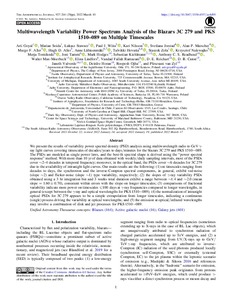Multiwavelength Variability Power Spectrum Analysis of the Blazars 3C 279 and PKS 1510-089 on Multiple Timescales
Goyal Arti; Soida Marian; Stawarz Łukasz; Wiita Paul J.; Nilsson Kari; Jorstad Svetlana; Marscher Alan P.; Aller Margo F.; Aller Hugh D.; Lähteenmäki Anne; Hovatta Talvikki; Zoła Staszek; Nalewajko Krzysztof; Tornikoski Merja; Tammi Joni; Hodges Mark; Kiehlmann Sebastian; Readhead Anthony C. S.; Max-Moerbeck Walter; Lindfors Elina; Ramazani Vandad Fallah; Reichart D. E.; Caton D. B.; Valverde Janeth; Horan Deirdre; Ojha Roopesh; van Zyl Pfesesani
Multiwavelength Variability Power Spectrum Analysis of the Blazars 3C 279 and PKS 1510-089 on Multiple Timescales
Goyal Arti
Soida Marian
Stawarz Łukasz
Wiita Paul J.
Nilsson Kari
Jorstad Svetlana
Marscher Alan P.
Aller Margo F.
Aller Hugh D.
Lähteenmäki Anne
Hovatta Talvikki
Zoła Staszek
Nalewajko Krzysztof
Tornikoski Merja
Tammi Joni
Hodges Mark
Kiehlmann Sebastian
Readhead Anthony C. S.
Max-Moerbeck Walter
Lindfors Elina
Ramazani Vandad Fallah
Reichart D. E.
Caton D. B.
Valverde Janeth
Horan Deirdre
Ojha Roopesh
van Zyl Pfesesani
IOP Publishing Ltd
Julkaisun pysyvä osoite on:
https://urn.fi/URN:NBN:fi-fe2022081155110
https://urn.fi/URN:NBN:fi-fe2022081155110
Tiivistelmä
We present the results of variability power spectral density (PSD) analysis using multiwavelength radio to GeV gamma-ray light curves covering timescales of decades/years to days/minutes for the blazars 3C 279 and PKS 1510-089. The PSDs are modeled as single power laws, and the best-fit spectral shape is derived using the "power spectral response" method. With more than 10 yr of data obtained with weekly/daily sampling intervals, most of the PSDs cover similar to 2-4 decades in temporal frequency; moreover, in the optical band, the PSDs cover similar to 6 decades for 3C 279 due to the availability of intranight light curves. Our main results are the following: (1) on timescales ranging from decades to days, the synchrotron and the inverse-Compton spectral components, in general, exhibit red-noise (slope similar to 2) and flicker-noise (slope similar to 1) type variability, respectively; (2) the slopes of gamma-ray variability PSDs obtained using a 3 hr integration bin and 3 weeks total duration exhibit a range between similar to 1.4 and similar to 2.0 (mean slope = 1.60 +/- 0.70), consistent within errors with the slope on longer timescales; (3) comparisons of fractional variability indicate more power on timescales <= 100 days at gamma-ray frequencies compared to longer wavelengths, in general (except between the gamma-ray and optical wavelengths for PKS 1510-089); (4) the normalization of intranight optical PSDs for 3C 279 appears to be a simple extrapolation from longer timescales, indicating a continuous (single) process driving the variability at optical wavelengths; and (5) the emission at optical/infrared wavelengths may involve a combination of disk and jet processes for PKS 1510-089.
Kokoelmat
- Rinnakkaistallenteet [27094]
